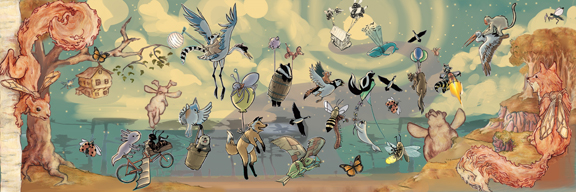
The Beehive Design Collective, a volunteer-driven, non-profit political organization that seeks to “cross-pollinate the grassroots” by creating collaborative, anti-copyright images that can be used as educational and organizing tools, will be guest artists in Associate Professor of Art Sandra Williams’ Art in the Community class in the Department of Art and Art History from Oct. 29-Nov. 2.
The Beehive Collective, based in Machias, Maine, are known for their large pen and ink posters and have distributed more than 75,000 posters completely by hand. The organization includes 14 “backbone bees” in Machias, but many other “autonomous pollinators” scattered throughout the Americas. Three “Bees” will be at UNL.
The Beehive Collective will present a public lecture on Monday, Oct. 29 at 5:30 p.m. in Richards Hall Rm. 15. The lecture is free and open to the public. In addition, an exhibition of their work will be on display Oct. 29-Nov. 2 in the Rotunda Gallery in the Nebraska Union. The exhibition is also free and open to the public.
“They’re known for doing these really intricate stone mosaics, as well as these graphics campaigns,” Williams said. “There are a number of them concentrated in Machias, Maine, but they’re scattered throughout the U.S. and Central America. The more I came in contact with them, the more I talked to the different ones, the more interesting they became.”
Some of the Beehive Collective’s recent graphics campaigns include “The True Cost of Coal,” about the effects of mountaintop removal coal mining; “Mesoamerica Resiste,” about the globalization in the Americas; and “Plan Colombia,” which looked at the issue of colonialism in the Andean Region of South America.
Emily Trauernicht, a junior art major from Hallam, Neb., is looking forward to the Beehive Collective’s visit.
“I expect their visit to be energizing and to excite our community to work together and learn about each other,” she said. “The Beehive Collective is about unity, and I hope that the students and our community members will learn skills from the Bee’s to harmonize.”
Trauernicht is taking the Arts in the Community Class for the third time this semester. Each semester’s class completes different community projects.
“I was first interested in Community Arts because I wanted to do more than make art in a studio. I wanted to explore working with others than just myself,” she said. “Since I have been working with Sandra Williams and our local community, I have been inspired to take on challenges and projects that I would have been scared to do in the past. We work together to achieve reachable and common goals. Art is a language shared by everyone.”
While in Lincoln, the Beehive Collective will visit with the Art in the Community class, but will also work with students at Park Middle School, Dawes Community Learning Center and McPhee Elementary during their visit.
One of the projects for the Art in the Community class this semester is to create an 8 foot by 24 foot long painted mural with students from Park Middle School for the new pedestrian underpass located near the roundabout at 14th and Superior sts. using imagery from the Beehive Collective.
Each of the 12 students in the Art in the Community class will be assigned a 4 foot x 4 foot square of the mural, which they will paint with students from Park Middle School.
“Part of our objective is not only to teach Lincoln Public Schools students about the content that Beehive Collective has been working with, but also using the grid as a formulating structure and how the grid is everywhere, especially in Nebraska,” Williams said. “When you look at the landscape, when you look at the city of Lincoln and city planning, when you look at steel framework construction. They will be able to understand the multiple ways the grid functions both in design and structurally, and they will be utilizing the grid themselves.”
Last semester, visiting artist and social pioneer Lily Yeh visited campus and helped create a mural design for the South Capital neighborhood. Yeh’s work included community arts projects in Rwanda, Kenya and Philadelphia.
“Similar to Lily and her use of using art in villages in Rwanda or Kenya, art was actually used as a method of economic development,” Williams said. “Once they had that kind of community foundation re-established through creativity, the village thrived. There are elements of that reflected in the Beehive Collective in the way they are interested in preserving this town of Machias. That’s a really fascinating element this idea of revitalization through using the arts—the idea of a group of people being able to work together, combining their talents, for the greater good.”
Since 2000, the Collective has been engaged in restoring the Machias Valley Grange Hall in Machias, Maine. Built in 1904, the Beehive Collective successfully placed the hall onto the National Register of Historic Places and are changing the goal and direction of the space towards the creation of a not-for-profit community cultural center.
“The Beehive Collective practice a lot of things that I practice in my class, where you have to give up personal authorship of the piece that you’re working on,” Williams said. “You really have no ownership of this piece. You’re really just using your skills to contribute to a larger mural or whatever it is that we happen to be working on. Hopefully their visit will open up an opportunity for our students who are really interested in community arts to go and practice and perhaps be a part of that for a couple of years.”
Trauernicht said her experiences in the Art in the Community class will help shape her future.
“It has been the most exuberating experience of my life,” she said. “Sandra has shown me how to be a community leader and challenges me to take the next step. I know exactly what I want to do with my career. I will be a community leader using art as a tool to bring communities together.”